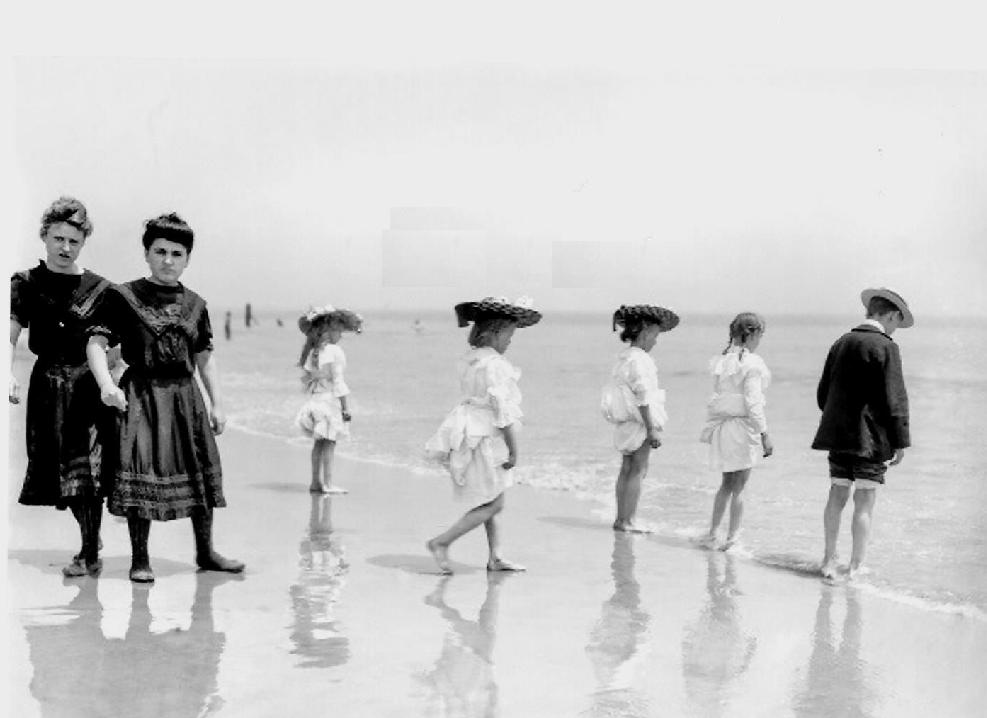
American Beaches and Resorts

Figure 1.--Unfortuntely we do not know when or where this photograph was taken. It looks to us to have been taken in the 1900s. Notice that the older girls wear long stckings while the younger girls are aloed to have bare legs. We are not sure where it was taken, but think it is somewhere along the northeast coast.
|
|
Beaches and ocean air began to become popular in the late-19th century at about the same time, the idea of a summer vacation began to take hold.Only a few American cities, however, had beaches that were close enough to used metropolitan city transport. A few cities like New York City had conveniently located beaches, but for others cities some travel was required and for many a great deal of travel. The country's growing railroad system soon offered inexpensived day trips to the beach from virtually every major city. In the second half of the 19th century, especially bythe 1870s, massive hotels as well as smaller rooming houses began to be built in easide locations. The more affluent could afford to stay in the luxurious hotels and resorts that sprang up at the major beach resorts. Well-to-do people sought out resorts. More modest Americans soughout out boarding houses. The Great Lakes offered beaches to the Mid-West. Almost all of the most-popular resorts were located along the coast or on an inland body of water. For Americans and Europeans, the resort and public beach were as much about status, social climbing, health, vanity, and fashion as sheer fun.
Day Trips
Train stations by 8:00 AM on wekdays would be croweded into trains running at short intervals from major northeastern cities. The railroad companies by the 1880s had girded the northeast with an expanding network of tracks. Trains ran from Philadelphia to Atlantic City and Cape May. A scooner also ran fromPhiladelphia to the beach resorts. Soon the beach resorts were teaming with men, women, and children. Hordes of day visitors stroll on rickity boardwalks. Other head for the water breaking on the beach. As the turn of the century approached, the beach was a novel event for the masses. For the first time Americans of modest means could vacation in the surf. Many had never seen the ocean or taken a vacation before. The price of admission was an inexpensive railroad ticket and the cost of a bathing suit.
Cottagers/Boardinghouse Guests
The somewhat more affluet and by mow tanned vacationers staying for extended periods in cottages and boardinghouses look ascance at the pale day trippers.
Hotels/Resorts: The wealthy of course would stay at hotels or resorts where they would not have to mingle with the masses.
Boardwalks
Boardwalks began appearing in the 1870s. Beaches: The most famous American beach was Coney Island. But the undisputed center of gravity along America's mid-Atlantic coast was Atlantic City, New Jersey. A luxurios hotel was built in 1875 followed by a boardwalk and amusement park.
Day Activities
The best part of the beach by the time the day trippers arrived would be filled by those with overnight accomodations and the day trippers would have to make do as best they could. Those who could afford it went to the small frame bathhouses where they could change into their bathing costumes--if they owned one--or rent a costume from the attendant.
HBC

Navigate the Boys' Historical Clothing Web Site:
[Return to the Main American seaside activities: Beaches and resorts page]
[Return to the Main seaside activities page]
[Introduction]
[Activities]
[Bibliographies]
[Biographies]
[Catalogs]
[Chronology]
[Clothing styles]
[Countries]
[Literary]
[Contributions]
[FAQs]
[Glossaries]
[Images]
[Links]
[Registration]
[Boys' Clothing Home]
Navigate the Boys' Historical Clothing Web Site:
[Sailor suits]
[Sailor hats]
[Buster Brown suits]
[Eton suits]
[Rompers]
[Tunics]
[Smocks]
[Pinafores]
Created: 3:52 AM 12/4/2016
Last updated: 3:53 AM 12/4/2016



